Here
is a sampling of images that I managed to save on CDs.
(Click for full-size image.)
|
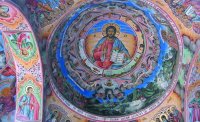 |
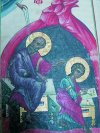 |
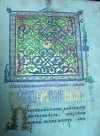 |
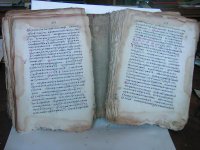 |
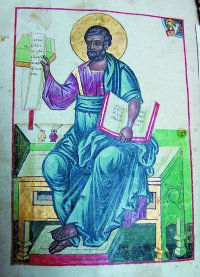 |
Like
many of you, I am a librarian. While earning an M.S. and an M.L.I.S., I
worked with special collections at the Society of Folk Dance Historians,
Saint Elias Orthodox Church, the University Catholic Center, and the Austin
(Texas) Graduate School of Theology. I created electronic catalogs for
some and advised others on preservation. Seeing the needs of these institutions,
I decided to pursue a Certificate of Specialization, and that led to the
quest that I'll describe here.
What started this quest?
While researching a homework assignment in 1999, I stumbled across the
Summer School in Digital Preservation of Slavic Medieval Manuscripts in
Sofia, Bulgaria. When I discovered those deeply hidden collections, rent
and silently suffering the dust and mold, I decided to dedicate my life
to salvaging them from the devastations of time. I attended the Summer
School, which convinced me of the manuscripts' value and their need for
help. Thus started my education in digital preservation and access, and
my quest to save the treasured Slavic medieval manuscripts.
In the U.S., I spent more
than 2 years fighting many battles, slaying the dragons of computer technology,
preservation and conservation technology, and global ignorance of the importance
of manuscripts. I saturated my mind and heart with digitization theory.
Then appeared the dragons of anxiety over the complex technological issues,
and my own lack of strength. Yet, where there is a will, there is a way!
I applied for and failed
to receive grants to go back to Bulgaria, but the manuscripts could not
wait. Back in November 2000, with my own money matched by funds raised
from my church parish, I had donated a computer to the manuscript collection
at the Historical and Archival Church Institute (HACI) in Bulgaria while
I was there for a conference. This donation opened the portals to the collection
and, a year later, HACI invited me to conduct research there through an
academic practicum. So in September 2001, I armed myself with a laptop
computer, a digital camera, a CD burner, and an inkjet printer, and I found
myself again in Bulgaria, digitizing one of the great medieval manuscript
collections. During the 3 months I spent at HACI this past winter, I created
an electronic catalog of its holdings and conducted a digitization pilot
project, producing CDs that contain images of its most endangered and most
beautiful treasures. I found my grail.
Now I will share with you
the story of my quest, starting with a bit of background on the nature
of Slavic medieval manuscripts and the digital divide between East and
West. Then I'll tell you how I approached the delicate digitization projects
of this extraordinary special collection.
Bulgarian Manuscripts
Bulgaria, a nation for
over 1,300 turbulent years, nurtured the Slavic literacy of Sts. Cyril
and Methodius, and Bulgarian scribes documented and transmitted the remnants
of classical Greek civilization throughout Eastern Europe. Yet the Renaissance
came late to Bulgaria, and her Slavic works remain inaccessible and unknown
to the Western world.
Although all special collections
with holdings of medieval manuscripts follow similar guidelines and protocols
for preservation and access, manuscript collections vary in their arrangement,
quality of facilities, environmental control, staff, and levels of preservation
and access. In Eastern Europe, foreign money and expertise have improved
the condition of some holdings through specialists such as David Birnbaum
from the University of Pittsburgh and Masudu and Kozhi Okamoto from Japan.
The HACI collection of 1,509
manuscripts and early printed books from the 10th to 19th centuries stands
out as a research institution and repository of valuable manuscripts and
archival documents. Among the early printed books, it holds incunabula,
the first edition of the famous 1581 Bible, and other beautifully gold-illuminated
manuscripts. Its miniatures with gold-plated frontispieces of the Evangelists
rank amongthe most beautiful of the Bulgarian manuscript decorations created
during the Turkish subjugation. Over the last 10 years, Slavic scholars
from Macedonia, Russia, Greece, Germany, Italy, France, and Belgium, in
a variety of fields such as linguistics, paleography and codicology, history,
art history, theology, medieval studies and literature, and Byzantine musicology,
have utilized the collection. Still, many foreign scholars do not know
of its existence, and even I, diligently studying the field and fluent
in Bulgarian, discovered it only by chance while doing the aforementioned
homework assignment.
The State of Information
Technology in Bulgaria
We talk about the "digital
divide" as the gap between societally advantaged individuals who use computers
and the Internet and the societally disadvantaged who do not. Well, this
"digital divide" also exists between the economically advantaged nations
and the disadvantaged world, including the former Soviet Bloc, and specifically,
the country of my birth, Bulgaria. The divide deprives both sides of many
treasures of human knowledge.
Special librarianship in
Bulgaria poses special challenges because of the economic crisis in the
country and the fragility of the objects, juxtaposed against the fantastic
intellectual and intrinsic wealth of the collections. Although Bulgaria
has a National Program for the Preservation of Library Collections, it
extends only to microphotography.
1
Only
two National Library manuscripts had been digitized when I embarked on
my project, and thosecame from the UNESCO "Memory of the World" project.
A few digital photography studios have appeared in the capital, Sofia,
but digital cameras remain outside the reach of ordinary citizens and research
institutions.
You might think that Bulgaria
ignores the digital revolution. Not so! Slavic linguists have approached
the issue of preservation and access from a unique angle, starting from
groundbreaking computer processing of manuscripts into SGML text encoded
for the Web. The Bulgarian Academy of ScienceInstitute of Bulgarian
Literature has worked since 1994 on the project "Repertory of Medieval
Bulgarian Literature and Letters," applying information technology to the
study of medieval Slavic manuscripts by encoding them to include the practices
of modern archaeology, paleography, codicology, and textology to create
an electronic union catalog.
2
Digital
images,
however, have lagged behind the coding and cataloging efforts.
"Access" implies different
things to different people. For us, the library professionals, access implies
an electronic catalog, perhaps with online capabilities for remote users.
One such example is the union catalog published by Hilandar Research Center,
3
providing
bibliographical access to some 2,300 Slavic medieval manuscripts stored
on microfilm and derived from 33 collections worldwide. This MARC-based
union catalog provides useful descriptive summaries of the contents of
those collections and multiple access points to the collection. For others,
however, access implies the ability to actually see and read the object
or an image of the object.
Stuart Lee asked "Is digitization
worth it?" in his article for the May 2001 issue of Computers in Libraries,
echoing other voices in the wilderness of digitization projects. His book,
Digital
Imaging: A Practical Handbook,
4
helped
me to understand the entire process of digitization, holistically and strategically.
For me, the answer blazed forth in letters of fire: Digitize! My Web quests
of 2000 had revealed no digitized South Slavic medieval manuscripts, compared
with multitudinous sites dedicated to the treasures of the Latin West.
5
I
decided to make visible to the rest of the world this significant facet
of human heritage, this missing link in the evolution of Western civilization,
these medieval treasures.
Going to Bulgaria and
Beginning the Real Work
Six days before the tragic
events of September 11, my lively 6-year-old daughter and I packed several
bags with electronic equipment and set out on our trip. The flights were
difficult and problems accompanied us along the way. For instance, we missed
connections due to a storm in New York; destinations changed; luggage vanished.
But finally we arrived in Bulgaria, somehow only an hour late in the scheduled
13-hour trip. After parental embraces, we headed home for a much-needed
rest.
A week later, I began the
long weekends at HACI in Sofia, and worked on the database and digital
images at home. I would remain there until November 25.
Organizing the Collection
via Electronic Catalogs
HACI had been working on
a descriptive catalog for several years with no projected date of completion.
The staff of academic historians lacked a true archivist or librarian.
I knew, as you know, that electronic catalogs provide incredible search
capabilities and facilitate all sorts of research and conservation measures,
and I resolved first to build their electronic catalog. Building the catalog
(I used Microsoft Access) helped me to understand the collection as a whole
and as individual items, and to collect statistical information about its
physical condition. I examined the existing inventory of books and all
existing descriptive catalogs of the collection and verified each datum
against the other sources.
I chose my database field
labels based on several works: the 10-year-old "collection condition and
inventory" book, two basic published descriptive catalogs of the Greek
and Slavic collections, and by individually examining items. I extracted
13 types of essential information that would identify each manuscript and
describe its physical condition:
1. Inventory number
2. Title
3. Date (century or year)
4. Material (parchment,
bombycine, or paper)
5. Medium (manuscript or
printed)
6. Ethnic origin (Slavic,
Bulgarian, Greek, Russian, Serbian, Jewish, Armenian)
7. Pagination and size
8. Presence of preservation
(non-acidic) folder
9. Damages to the binding
10. Overall condition of
the binding (excellent, good, satisfactory, bad)
11. Damages to the text
block
12. Overall condition of
the text block
13. Additional notes about
emergency cases for restoration of manuscripts
This catalog, although very
concise, still supplied the staff and the users with an increased degree
of order and logical sequence, authentication, identification, standardization
of language, authority control, searchability, and ability to create classification
and systematization schemes.
This catalog of information
enabled me to understand the history of Bulgarian book production and to
identify patterns and trends. The history of manuscript production parallels
historical events to trace paths of distribution and to find milestones
such as changes of medium: parchment to paper, manuscript to printed format.
Finally, this catalog enabled me to gather accurate statistical information
about the collection that I can use on applications for support from sponsoring
agencies. I spent about 70 hours in creating that electronic catalog of
1,509 items, but the results were tremendous. Later I delivered that catalog
to interested research institutions in Bulgaria and in North America for
their reference.
Discussing Digitization
After creating the catalog,
but before considering digitization as a viable option for access, I talked
at length with the director, the staff, and the scholar-users of this collection.
My survey revealed that the majority of the scholars would not object to
using an electronic copy of a manuscript, yet a great many of them implied
that they would always like to consult the original. We agreed at this
stage to digitize for access purposes rather than for high-resolution archival
purposes, to create CD-ROMs for local use of scholars and for other institutions,
and later to create a Web site dedicated to Slavic Medieval Manuscripts
for remote users. We decided to create images for access because of the
large digital storage requirements of high-resolution, archival images.
(However, for the next stage of digitization, we will use archival-quality
digital imaging and special conservation treatment for the most endangered
manuscripts.)
This selection process required
the most time and effort. Again, I consulted with the HACI staff and users,
and I also examined the usage log for the institution, which listed manuscripts
requested for study from 1990 to 2001. This thorough analysis produced
patterns of manuscript usage and scholars' preferences for certain genres,
titles, and periods of production. In the end, parchment manuscripts, the
"Greek Collection," items in the worst physical state, and items most used
headed our list. Our fundamental criteria came from Hazen, Horrell, and
Merrill-Oldham's criteria for selection.
6
Some technical experts try
to scare us with too-high standards. Yet, a sense of sobriety always comes
to me from the pioneering experience of the National Library of the Czech
Republic Manuscript Digitization Projects. They relied on their users,
the researchers, rather than on technical experts, to define standards
for image quality. My experience paralleled theirs. I surveyed the HACI
users and found that they valued the information, i.e., the text, the marginal
notes, or the ornamentation. They wanted the image rather than the object,
per se. They appreciated the availability of the access tool, the CD-ROM.
True, researchers of primary materials sometimes need to touch the object
to identify with it, and these users were no different. Yet the eyes of
ancient scribes resemble the eyes of contemporary scholars, according to
Stanislav Psohlavec, director and one of the digitization experts at the
Czech National Library,
7
justifying
research from images rather than from objects.
We decided that the most
endangered manuscripts deserved special treatment first. By digitizing
them, we could provide examples of the desperate physical condition to
show to resource-granting agencies. Then, we chose superb specimens of
artistic and intellectual endeavor to represent Slavic manuscript heritage
on the Web.
To discover the limits of
digitization, we experimented with national church history photographs
from the 19th century, and to establish time requirements, I digitized
a special 1771 copy of a Bulgarian chronicle, Istoria Slavyanobolgarskaya,
240 pages, in about 90 minutes.
The Equipment I Used
I purchased a 3.3 megapixel
Toshiba PDR-M70 digital camera, able to achieve high-quality and high-resolution
images of up to 2048 x 1536 pixels. The camera proved to be easy to learn,
use, and carry. The images, stored in its Smart Media card, downloaded
to the computer easily. Writing to CD-ROM presented no problems, although
I must study multimedia presentation to make future images more appealing
and useful. I took a Hewlett-Packard 840C color printer to share the images
with HACI, and it too presented no problems, producing stunning color photos
of the manuscripts.
The Works That I've Saved
Seven CD-ROMs emerged from
this project:
1. "Endangered
Manuscripts from HACI," containing the most harmed manuscripts. This should
be useful for fundraising.
2. "The Treasures from HACI,"
containing superlative aesthetic images, also useful for fundraising
3. "Istoria Slavyanobolgarskaya,"
the chronicle mentioned above
4. "Bulgarian Church History
of the 19th Century," the national church history thematic photograph collection
Subsequently, I visited Rilski
monastery in southwest Bulgaria, one of the major medieval scriptoria and
libraries of the 12th to 15th century Balkans, where I created a fifth
CD-ROM: "The Treasures of Rilski Monastery."
Rumors among scholars in
Sofia hinted at treasures in Gabrovo, my hometown. I returned to Gabrovo
and discovered two neglected manuscripts that became the subjects of two
final CD-ROMs: "The Life and Service of St. Onuphrius," a manuscript from
the Mount Athos monastery concerning the life of St. Onuphrius of Gabrovo;
and "Chronicle of Hieromonk Spiridon," the only extant copy of this famous
document, housed in the Gabrovo Historical Archive. All of these images
have proved of great interest to the scholarly community.
How good are the images?
They do not compare with those of digitization experts who use tripods,
copy stands, archival-quality resolution, and special lighting. Field conditions
cannot compare with studio work, and the wise curator does not allow objects
to leave the storage facility. Yet, with limited experience and funds and
under field conditions, I achieved my goals, producing images that amazed
and pleased the scholars who used them.
What I've Done So Far;
What I Have Yet to Do
In sum, I spent 200 hours,
$1,100 on equipment, and $1,000 on travel to create the electronic catalog
and the seven CDs. Nothing lasts forever, but the images of manuscripts
that I digitized should continue to benefit scholars for years to come
and also help to preserve the manuscripts from excessive handling. Yes,
one person can make a difference.
I again have applied for
grants to help provide digital access and preservation to the HACI collection
and to other collections. Soon, I will construct a Web site featuring the
manuscripts with historical context, and someday I hope to expand the site
into a virtual reunification of all existing Slavic manuscripts. Next year,
I would like to help the Bulgarian library community to create a National
Digitization Program and Strategic Policy in Digital Preservation. Will
my quest result in the deeds actually being done? I don't know. Will the
deeds occur without the quest? Definitely not.
I hope that we in the West
will appreciate more what we already have, and that this article will inspire
and guide you to make your special collection more accessible even if you
have only limited resources at hand.
|